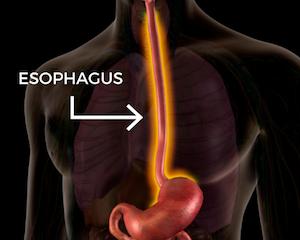 Esophageal stenosis is a medical condition in which the esophagus (the tube which transmits foods and liquids from the mouth to the stomach) becomes abnormally tight and constricted. Esophageal stenosis (also called “esophageal stricture”) can be caused by a number of different things including: physical trauma, surgical complications, and chronic inflammation.
Esophageal stenosis is a medical condition in which the esophagus (the tube which transmits foods and liquids from the mouth to the stomach) becomes abnormally tight and constricted. Esophageal stenosis (also called “esophageal stricture”) can be caused by a number of different things including: physical trauma, surgical complications, and chronic inflammation.
Constriction or narrowing of the esophagus can cause difficulty swallowing (dysphagia). Esophageal stenosis disrupts the physical process of passing food and liquids through the esophagus. This can result in a feeling of fullness or pressure in the chest and in some cases the complete inability to swallow at all. Esophageal stenosis can also cause breathing difficulty for prolonged time periods and require emergency medical attention.
Causes of Esophageal Stenosis
Esophageal stenosis or stricture is caused when trauma or irritants to the esophageal lining cause inflammation and create scar tissue inside the esophagus. Eventually this inflammation and scarring can cause the esophagus to narrow and constrict enough to interfere with swallowing and become esophageal stenosis. The specific causes of the inflammation and scarring that can lead to esophageal stenosis include:
- Chronic gastroesophageal reflux disease (GERD)
- Physical trauma to the esophagus lining (endoscope injuries, pills or object stuck in throat, etc.)
- Prolonged use of medical feeding tube during hospital stay
- Post-operative complications
- Swallowing harmful, corrosive chemicals such as battery acid or cleaners
- Radiation treatment on the throat
- Esophageal cancer
Symptoms and Complications of Esophageal Stenosis
Physical symptoms associated with esophageal stenosis tend to be fairly consistent in most cases, but varying in terms of severity based on the degree of esophagus stricture. The primary symptoms of esophageal stenosis or stricture include:
- Pain, discomfort, and difficulty swallowing
- Heartburn and chest pain after eating
- Excessive burps or hiccups
- Feeling of tightness as if something is stuck in the throat after eating
- Regurgitation of food and liquid
These symptoms of esophageal stenosis can frequently lead to more serious complications if the condition goes untreated. One of the more serious complications is the potential for foods and other solids to become stuck deep in the esophagus as the lining narrows. This can be very uncomfortable and lead to a constant choking sensation and difficulty breathing.
Another very serious complication that can result from untreated esophageal stenosis is pulmonary aspiration. Pulmonary aspiration can occur when solids or liquids trapped in the esophagus can enter into the lungs. This can lead to aspiration pneumonia from bacteria in the foods and solids entering the lungs.
Diagnosis of Esophageal Stenosis
Diagnosing esophageal stenosis usually starts with the identification of symptoms and a general physical examination by a primary care doctor. When esophageal stenosis is suspected, the primary care doctor will generally refer the patient out to a gastroenterologist for further testing.
The gastroenterologist will perform a number of tests that are designed to rule out various types of cancer and diagnosis non-malignant conditions such as esophageal stenosis. The G.I. diagnostic tests that can be used in this process include:
- Barium Esophagram: (also called a “barium swallow test” or “swallowing study”) this a specialized type of X-ray that uses barium to create images of the upper gastrointestinal tract, including the esophagus. The patient swallows barium fluid and the X-rays are taken that give doctors images of the swallowing mechanism.
- CT Scan: a computerized tomography scan (CT Scan) of the throat and neck will usually be done to rule out cancer as the cause of the patient’s symptoms. If a lesion is identified it will be biopsied.
- G.I. Endoscopy: in an upper G.I. endoscopy a tiny camera is inserted into the esophagus to give doctors visual images of the inside of the throat. This procedure must be done with a high level of care or it can cause further damage to the esophagus lining.
Treatment Options for Esophageal Stenosis
There are number of different treatment options available for esophageal stenosis. The specific treatment plan will vary depending on the severity of an individual case and other health circumstances. Treatment options include:
- Esophageal Dilation: this involves stretching out and opening of the esophagus to alleviate the symptoms caused by narrowing. In most cases this procedure only gives temporary relief and must be repeated periodically.
- Esophageal Stent: in this procedure a stent (a small expandable mesh tube) can be surgically placed inside the esophagus to help keep it open and prevent narrowing.
Medication for treatment of underlying conditions such as GERD and changes in lifestyle and diet are also common options for treatment.
 Medical Malpractice
Medical Malpractice





